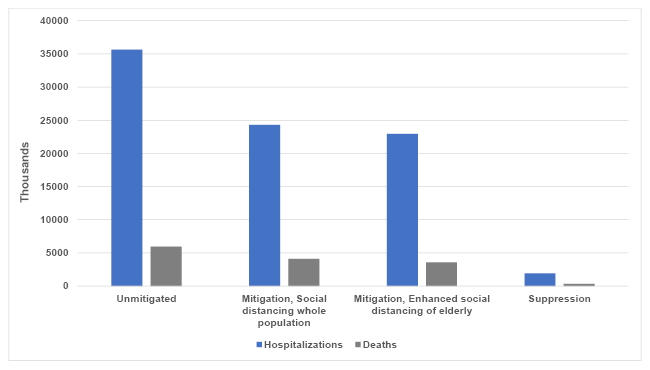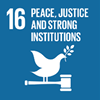Background Note
COVID-19 and socioeconomic impact in Asia
The case of India
Several countries have enacted lockdown measures in the wake of the COVID-19 pandemic to protect their health systems and reduce the number of mortalities. One of the most extreme national lockdown measures has been taken by the government of India, with over 1.3 billion persons put under a strictly enforced lockdown on 24 March for an initial period of three weeks.
What has the government of India done with respect to COVID-19 measures of mitigation and suppression?2
As of 3 April 2020, India had confirmed 2,567 cases of COVID-19 and 72 deaths.1 Given the poor state of the country’s public health infrastructure and that millions of residents in urban areas live in densely packed informal settlements where interpersonal contact is likely to be very high, India’s government announced a national lockdown ordering all citizens to stay at home for an initial period of three weeks. The lockdown followed an initial policy of a 14-hour voluntary public curfew initiated on 22 March, and after several Indian state governments had announced similar lockdowns in their own jurisdictions. As a consequence of the lockdown, public transport (including long-distance trains) and domestic and international air travel were suspended.
Figure 1: Projected hospitalizations and deaths in India under different mitigation and suppression measures

While India’s lockdown was announced when the number of cases was not particularly high relative to the population (there were 500 cases when the lockdown was announced), the public health implications of rapid community transmission, especially from the urban areas to rural areas, were clearly on the minds of the national political leadership in initiating such a drastic shut down of economic activity. Figure 1 makes clear that if COVID-19 was allowed to continue unabated, an estimated 35 million individuals would have been hospitalized and 6 million deaths would have occurred, according to the epidemiological modelling of the global impact of COVID-19.3
If mitigation measures of mild social distancing of the entire population (reducing social contact rates by 45 per cent) and social distancing of the elderly (reducing contact rates of the elderly by 60 per cent) had been enacted, the number of deaths would reduce to 4 million and 3 million respectively. A national lockdown—which is equivalent to a suppression strategy that reduces interpersonal contact rates by 75 per cent—would, however, lead to only 0.3 million deaths caused by COVID-19. Therefore, there was a strong underlying public health rationale for India’s national lockdown policy, stringent as it undoubtedly was.
What are the economic implications of these measures on the poor and most vulnerable?
The immediate response to the announcement of the national lockdown was the attempted flight of millions of migrant workers from Indian cities back to their rural residences. For these workers, who survive on daily wages and work in India’s large informal sector4, the shutdown of economic activity meant that they had no means of livelihood in their places of work, nor the family support systems that they needed to survive without any source of income for a prolonged period. With the attempted return migration of these workers back to their villages, there was a considerable risk of community transmission in rural India if some of these workers were carrying the coronavirus. The unexpected announcement of the national lockdown and the lack of preparation by the national government in India meant that the mass exodus of migrant workers became a chaotic event.
Migrant workers were prepared to walk on foot for long distances back to their villages; until finally, the state governments of Delhi and Uttar Pradesh intervened to offer public transport to return them to their home states.
It is likely that the lockdown policies along with the global economic contraction associated with the COVID-19 pandemic will affect the poor and the vulnerable both in the rural and urban sectors. In the rural sector, falling crop prices for winter-sown crops is likely to have a large negative effect for the large workforce employed in the agricultural sector. In the urban sector, the freezing of day-to-day economic activity is likely to lead to large income losses for casual workers and the self-employed in the informal sector.5
While it is too early to assess the full economic impact of the national lockdown, we can expect a sharp contraction in GDP for the next quarter with the brunt of the effect felt in the urban informal sector and in the agricultural sector—both being sectors largely inhabited by India’s poor. Whether the contraction is V-shaped or U-shaped will depend on the length of the lockdown and the effect of the fiscal stimulus package enacted by the government.
What supporting measures did the Indian government take to protect the poor and the vulnerable?
India’s government announced a nearly US$23 billion economic package on 26 March 2020 to support the poor, providing rations of grains and pulses, free gas cooking cylinders to 83 million families, and cash transfers of US$6.65 a month to about 200 million women for the next three months. While the size of the stimulus package was large by international standards, concerns remain on whether the additional allocations of food through the public distribution system and the cash transfers would reach the poor without delay.
This is because the Indian state has been notoriously weak in the implementation of its delivery of public goods and welfare programmes. As one commentator has remarked, India has been ‘a flailing state’, rather than a failing state. However, there is evidence to suggest that the Indian state ‘performs much better in activities that are episodic in delivery and accountability, and where, therefore, exit is automatic once the activity is complete’. If this is the case, it could be argued that a one-time mass mobilization of resources and administrative machinery that is necessary to allocate the food, cooking gas cylinders, and cash transfers to the poor may well be within the capabilities of the Indian state.
In addition, the fact that the current government has managed to reach out to a large proportion of the poor over 2014–19 and make sure that they have biometric Aadhar cards6 as well as bank accounts (through the Jan Dhan Yojana scheme) makes it very likely that gas cylinders and cash transfers will reach the intended beneficiaries.
Given India’s federal structure, several state governments have also announced measures to assist the poor and vulnerable in the wake of the pandemic. For example, the Kerala state government announced a financial package worth US$2.7bn that covers a health package, loan assistance, welfare pensions, free food grains, subsidised meals, and tax relief.
The West Bengal government announced free food grains and rations under a public distribution system for the next six months. Similar measures which augment food rations for an extended period of time were announced by state governments. These measures may imply that the poorest of Indians may not face hunger and starvation of the same magnitude witnessed in the 1918 flu pandemic, when over 11 million people died over a six-month period. However, the efficacy of these measures depends to a large extent on the competencies of state bureaucracies, with southern state governments more widely known for their ability to deliver welfare programmes to the poor.
What needs to be done more to protect the poor and vulnerable?
For the Indian government, there are two possible routes to follow after the initial three-week period of lockdown. The first route is extending the period of the lockdown if the current suppression strategy has not brought transmission rates down to a sufficiently low level.7 However, further extending the period of lockdown implies prolonging the hardships faced by the working poor. In addition, a longer lockdown period implies that those who may not have been as badly affected by the initial shutdown of economic activity may become more vulnerable over time (for example, households that are just above the poverty line and who may not receive the welfare schemes reserved for poorer households). In this case, it would be necessary for the national and state governments to scale up welfare programmes and consider moving to universal basic income programmes as targeted schemes may not be optimal in the current environment, where the majority of the population are facing severe hardship.
A second route would be to allow a section of the population, those in an age group which has lower risk of mortality, to return to work. This could be, for example, workers in the age range 20–40 years old. This can be combined with mass testing for antibodies, so that workers who have developed immunity to COVID-19 can return to work. Since, in an extended Indian family, it is very likely that there will be adults in the 20–40 age group, this allows most families to have a lifeline and ensure that the working poor are not shut out completely from their livelihoods.
Clearly, neither route—a prolonged national lockdown or a partial return to economic activity—is optimal in all circumstances and for all households. It would be necessary for the Indian government to balance the benefits and costs of each route, both in terms of their public health implications and their possible effect on poverty and vulnerability.
Whatever the route taken, it would be necessary for the government to consult all key stakeholders, including public health professionals, civil society representatives, and economists, so that there is a consensus on the best way forward given the very difficult circumstances.
 Join the network
Join the network